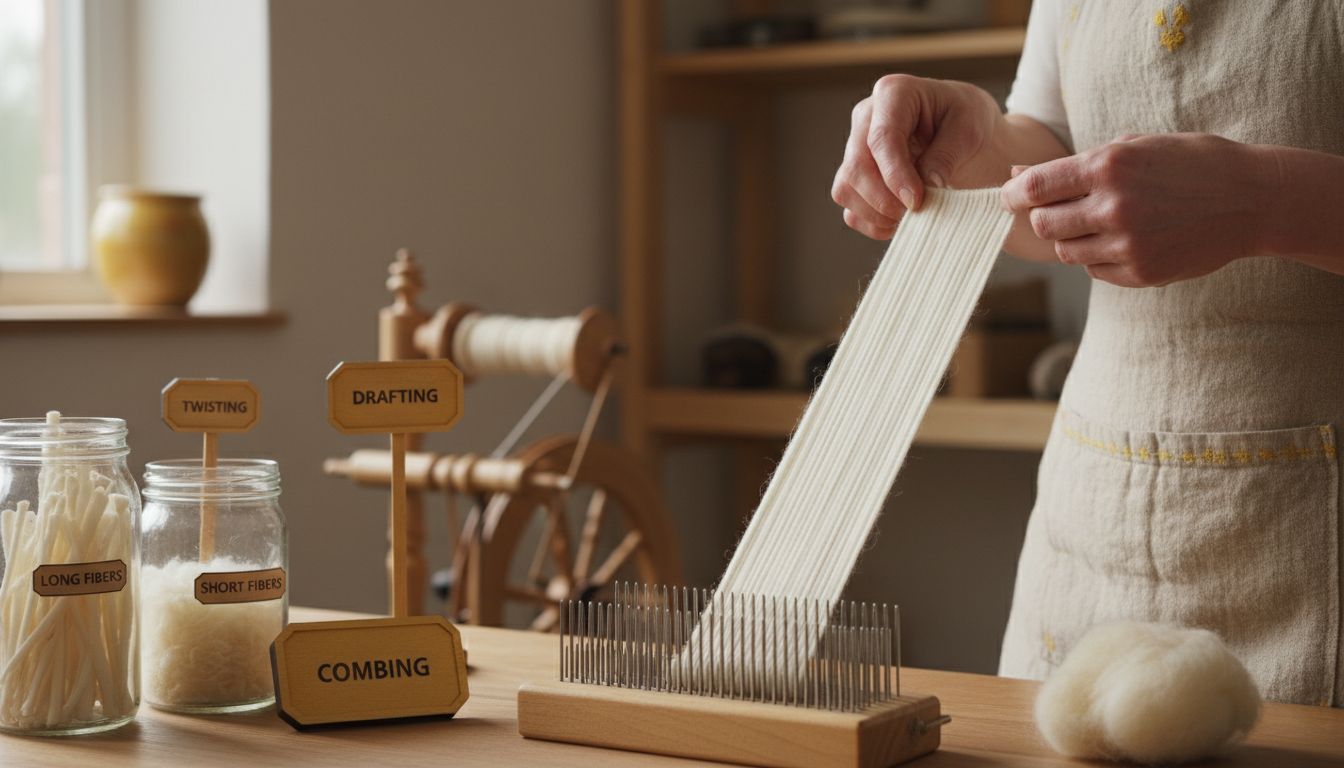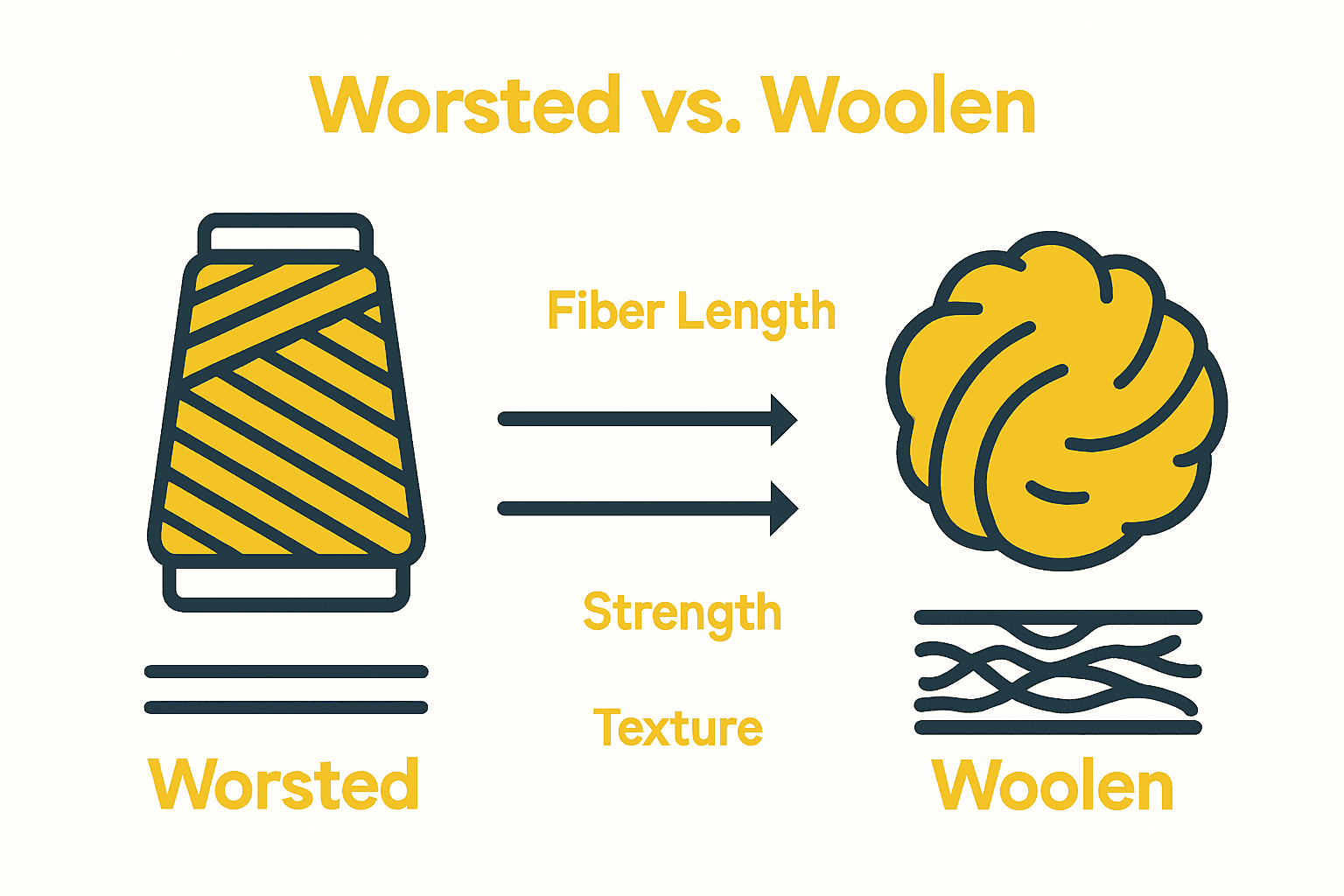
Worsted Spun Yarn: Everything You Need to Know
Did you know that worsted spun yarn gets its smooth texture and lasting strength from a process that uses only the longest and most uniform wool fibers? This method stands out in the textile world because it creates yarns perfect for sharp suits and sturdy, elegant crafts. Understanding how these fibers are selected and spun helps you make smarter choices for quality projects, whether you knit, crochet, or simply value high-performance fabrics.
Table of Contents
- Worsted Spun Yarn Defined and Demystified
- Core Features of Worsted Spun Process
- How Worsted Spun Differs From Woolen Spun
- Best Uses for Worsted Spun Yarn Types
- Common Mistakes When Using Worsted Spun
Key Takeaways
| Point | Details |
|---|---|
| Definition of Worsted Spun Yarn | A sophisticated method that uses longer, uniform wool fibers to create a premium, smooth yarn suitable for high-quality textiles. |
| Spinning Process | Involves careful fiber selection, combing, drafting, and twisting, resulting in strong, structured yarn with minimal fuzziness. |
| Comparison to Woolen Spun Yarn | Worsted spun yarn is smoother and stronger due to its long fiber composition, whereas woolen spun yarn is fuzzier and less durable. |
| Common Uses | Best for professional clothing, tailored suits, and high-end knitwear that require durability and a sleek appearance. |
Worsted Spun Yarn Defined and Demystified
Worsted spun yarn represents a sophisticated textile production technique that transforms wool fibers into a premium, smooth, and highly structured yarn. According to americanwool.org, worsted fabrics emerge from longer wool fibers that undergo an extra combing process, resulting in a tighter spun yarn commonly used in wool suits and high-quality textiles.
The defining characteristic of worsted spun yarn lies in its unique preparation method. Unlike traditional wool spinning techniques, this process selects longer, more uniform wool fibers, typically sourced from longhaired sheep. As engines.egr.uh.edu explains, this meticulous approach yields a more orderly yarn that produces harder and smoother cloth compared to traditional wool spinning methods.
Key features of worsted spun yarn include:
- Exceptional smoothness and uniform texture
- Superior strength and durability
- Enhanced ability to maintain shape and structure
- Minimal fiber fuzziness
- Higher density and tighter fiber alignment
The spinning process involves several critical steps that differentiate worsted yarn from other textile production methods. Wool fibers are carefully combed to align them parallel to each other, removing shorter fibers and creating a sleek, compact yarn. This precise technique results in a textile product that is simultaneously refined, strong, and versatile, making it a preferred choice for high-end clothing, professional attire, and sophisticated craft projects.

For crafters and textile enthusiasts looking to understand more about yarn varieties, check out our comprehensive guide on worsted weight yarn.
Core Features of Worsted Spun Process
The worsted spun process is a sophisticated textile manufacturing technique that transforms raw wool fibers into a high-quality, refined yarn with exceptional characteristics. prod.makethelabelcount.org reveals that during worsted spinning, the roving undergoes a precise drafting process before entering the twisting zone, where a predetermined amount of twist is inserted to produce a singles yarn.
Key stages in the worsted spinning process include:
- Fiber selection: Choosing long, uniform wool fibers
- Combing: Aligning fibers parallel to each other
- Drafting: Carefully stretching and thinning the fiber bundle
- Twisting: Inserting controlled twist to create yarn strength
- Finishing: Ensuring consistent yarn quality and appearance
According to americanwool.org, this method specifically utilizes longer wool fibers that undergo an extra combing process, resulting in a tighter spun yarn ideal for high-quality textiles. The meticulous approach sets worsted spinning apart from traditional spinning methods by creating a more uniform, smoother, and more durable yarn product.
The precision of the worsted spinning process allows for remarkable control over yarn characteristics. Manufacturers can manipulate fiber alignment, twist intensity, and yarn thickness to create textiles with specific performance properties. This makes worsted spun yarn particularly valuable in industries ranging from fashion and apparel to specialized crafting applications.
For crafters interested in understanding more about yarn production techniques, explore our understanding the role of yarn spin tutorial.
How Worsted Spun Differs From Woolen Spun
The fundamental distinction between worsted and woolen spun yarns lies in their preparation, fiber characteristics, and resulting textile properties. According to americanwool.org, woolen fabrics are crafted from shorter wool fibers, creating a distinctively fuzzy texture, while worsted fabrics utilize longer fibers that undergo an extra combing process, resulting in a tighter, more refined spun yarn.
Key differences between worsted and woolen spun yarns include:
- Fiber Length: Worsted uses long, uniform fibers; woolen uses shorter, more varied fibers
- Texture: Worsted produces smooth, sleek yarns; woolen creates softer, fuzzier textures
- Fiber Alignment: Worsted fibers are precisely parallel; woolen fibers are more randomly oriented
- Strength: Worsted yarns typically demonstrate superior strength and durability
- Performance: Worsted yarns maintain shape better and show less pilling
Engines.egr.uh.edu further explains that worsted yarn, spun from longhaired sheep’s wool, yields a more orderly yarn structure that produces harder and smoother cloth compared to traditional woolen spinning methods. This precision in production allows worsted yarns to excel in applications requiring crisp, structured fabrics.
The spinning technique fundamentally transforms the wool’s inherent characteristics. While woolen spinning embraces the natural loftiness and soft irregularity of wool, worsted spinning creates a more controlled, refined yarn product. This makes worsted yarns particularly valuable in professional clothing, tailored garments, and high-performance textile applications where consistency and smooth finish are paramount.
Here’s a comparison of worsted spun and woolen spun yarns:

| Characteristic | Worsted Spun Yarn | Woolen Spun Yarn |
|---|---|---|
| Fiber Length | Long, uniform fibers | Short, varied fibers |
| Texture | Smooth, sleek | Soft, fuzzy |
| Fiber Alignment | Parallel, orderly | Random, lofty |
| Strength | High durability | Lower durability |
| Shape Retention | Excellent | Moderate |
| Best Uses | Suits Tailored garments Structured projects |
Cozy blankets Soft sweaters Warm accessories |
For crafters seeking to understand more about yarn varieties, explore our guide on worsted yarn qualities.
Best Uses for Worsted Spun Yarn Types
Worsted spun yarn offers remarkable versatility across multiple crafting and textile applications, distinguished by its superior quality and performance characteristics. americanwool.org highlights that these fabrics, made from longer wool fibers, are particularly suitable for creating wool suits and t-shirts due to their tightly spun yarn structure.
Ideal applications for worsted spun yarn include:
- Professional clothing and tailored suits
- High-end knitwear and sweaters
- Upholstery and home textiles
- Winter accessories like scarves and hats
- Durable crafting projects requiring structure
- Precision knitting and crochet work
Engines.egr.uh.edu explains that worsted yarn, spun from longhaired sheep’s wool, produces harder and smoother cloth ideal for applications demanding durability and a sleek appearance. This makes it especially valuable in creating garments and textiles that require consistent texture and long-lasting performance.
Crafters and textile professionals appreciate worsted spun yarn for its exceptional characteristics. The yarn’s precise fiber alignment and smooth finish make it perfect for projects requiring clean lines, minimal pilling, and excellent shape retention. From intricate sweater patterns to structured home decor items, worsted spun yarn provides the reliability and aesthetic quality that discerning crafters seek.
For crafters looking to expand their yarn knowledge, check out our guide on essential yarn types.
Common Mistakes When Using Worsted Spun
Working with worsted spun yarn requires precision and understanding of its unique characteristics. prod.makethelabelcount.org emphasizes that proper twist levels and yarn count are crucial in ensuring optimal yarn quality and performance.
Common mistakes crafters make with worsted spun yarn include:
- Ignoring gauge and tension requirements
- Using inappropriate needle or hook sizes
- Failing to account for yarn’s specific drape and structure
- Overlooking fiber care instructions
- Mixing worsted spun yarn with incompatible yarn types
- Incorrect washing or blocking techniques
Americanwool.org warns that incorrect processing or finishing can significantly affect the quality and characteristics of worsted fabrics, potentially compromising the entire project. Crafters often underestimate the importance of understanding the yarn’s unique properties before beginning their work.
The precision required for worsted spun yarn means that even small mistakes can lead to substantial differences in the final product. Tension control is particularly critical, as worsted yarn’s tight, uniform structure demands consistent stitch formation. Experienced crafters recommend practicing with swatches and carefully measuring gauge to ensure project success.
For crafters seeking to improve their yarn selection skills, explore our guide on yarn gauge.
Discover the Power of Worsted Spun Yarn for Your Next Project
Struggling to find yarn that delivers the perfect balance of strength, smoothness, and structure? Worsted spun yarn offers all these qualities and more but requires the right materials to truly shine. Whether you are crafting professional attire, refined knitwear, or structured home textiles, selecting the right yarn can make all the difference. You deserve yarn that lives up to the meticulous standards of worsted spinning with consistent quality and durability.
.png)
Explore our expertly curated Yarn collection at CRAFTISS where you can find high-quality fibers designed to elevate your projects with ease. Act now to experience yarns that match the tight fiber alignment and smooth finish described in “Worsted Spun Yarn: Everything You Need to Know.” From beginners to seasoned crafters, our premium yarns provide the reliability and beauty you need to turn your creative vision into reality.
Ready to bring your worsted yarn projects to life? Visit CRAFTISS today and unlock access to yarns that make intricate knitting and crochet simple and satisfying.
Frequently Asked Questions
What is worsted spun yarn?
Worsted spun yarn is a type of yarn made from longer, uniform wool fibers that have been combed to be parallel, resulting in a strong, smooth, and structured yarn ideal for high-quality textiles and garments.
How does worsted spun yarn differ from woolen spun yarn?
Worsted spun yarn uses long, uniform fibers that create a smooth, tightly spun product, while woolen spun yarn is made from shorter, varied fibers that produce a softer, fuzzier texture. Worsted yarn is stronger and retains its shape better than woolen yarn.
What are the best uses for worsted spun yarn?
Worsted spun yarn is ideal for professional clothing, high-end knitwear, upholstery, winter accessories, and projects requiring durability and a clean finish, such as structured garments and precision knitting.
What common mistakes should I avoid when working with worsted spun yarn?
Common mistakes include ignoring gauge and tension requirements, using incorrect needle sizes, overlooking specific care instructions, and failing to account for the yarn’s structure. Proper measurements and swatching can help ensure project success.


